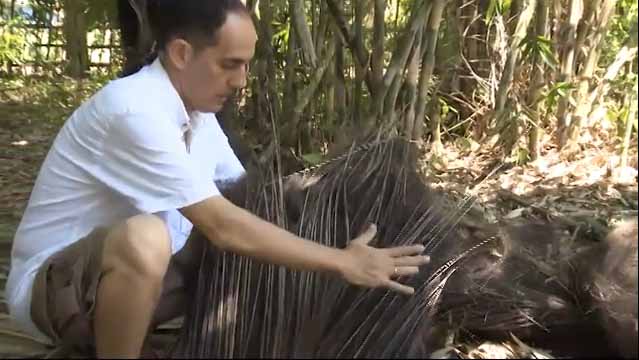In Manado, at the picturesque tip of North Sulewesi in remote Indonesia, local artisanal gold miners may have found, in their backyards, the key to reducing mercury emissions.
Across Indonesia, you can see roofs of houses made from ijuk, a strong and sturdy fiber that comes from the bark of the sugar palm tree that grows all over Indonesia.
Ijuk has long been a useful part of local life. It is also used to make ropes and brooms, and now, local artisanal miners have found that ijuk can be used instead of mercury in the gold extraction process. The Manado method, as it is called, can even yield twice as much gold.
Our partner in Indonesia, the local NGO Yayasan Tambuhak Sinta (YTS), alerted us to the enormous potential of the Manado method.
In Manado, the widespread use of mercury in artisanal gold mining is especially troubling because of its proximity to the sea. Mercury released in the hills surrounding the harbor drops into the water and poisons the seafood, which is then consumed.
Once released, mercury can also travel vast distances. So it not only poisons Indonesian miners, their families and nearby communities, but also people living half a world away.
One of the largest gold producers in the world, Indonesia is responsible for about 10 to 30% of worldwide mercury emissions.
If the Manado method using ijuk works in other parts of Indonesia, imagine the impact.
Pure Earth is currently working with YTS to demonstrate the Manado method to miners still using mercury.
This video proves that extracting gold without mercury is not only possible but easy, safe, and more cost effective.
As one miner in the video puts it, with the Manado method, they would no longer have to buy mercury, which costs about $150 a kg. Ijuk is plentiful and can be used over and over again for months.
“Isn’t it wonderful how the Indonesian miners have found an alternative to mercury by going back to nature?” says Sumali Agrawal, technical director of YTS.
Pure Earth is working in Indonesia and many other artisanal gold mining communities in countries around the world to reduce the impact of toxic mercury while maintaining livelihoods.
Different methods work at different sites. We are testing a variety of approaches, including some that eliminate the use of mercury entirely, as well as others that use (and recapture) mercury.






